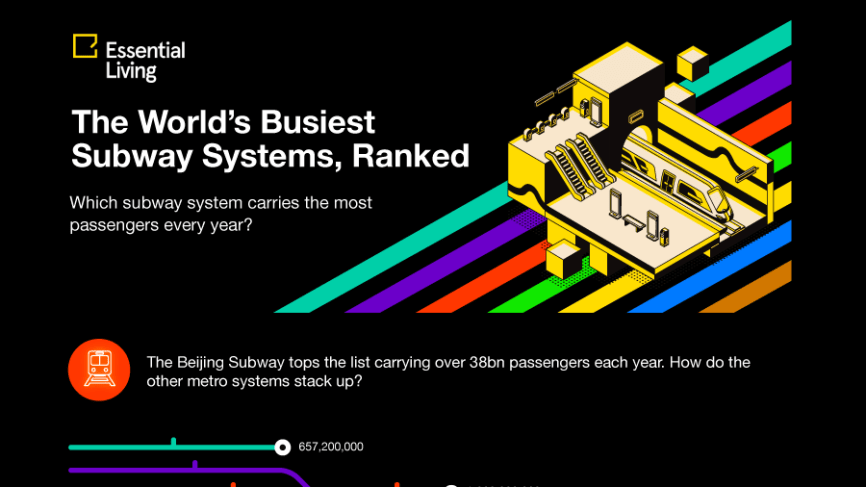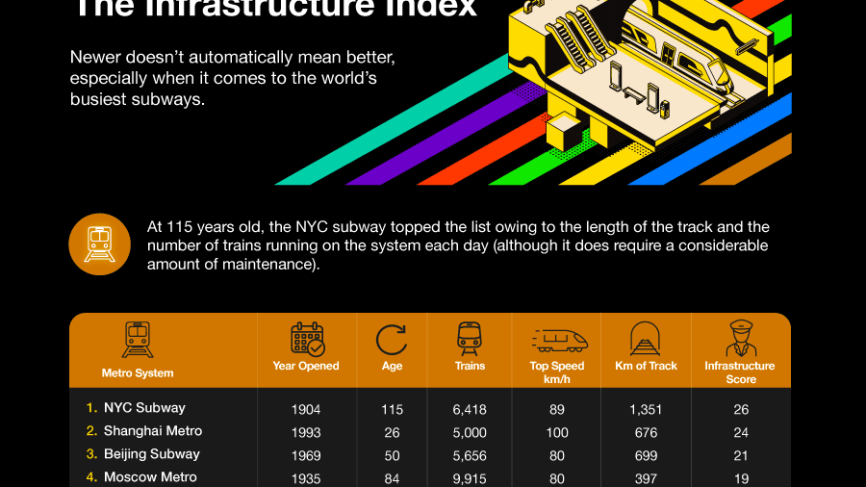How many of these subway systems have you travelled on? We’ve revealed which of the busiest metro systems around the world are the best, according to passenger experience.
There’s a lot to be said for the subway. No road rage, no traffic and no sat nav to worry about. But which subway tops the list as the best for travellers?
Whether you travelled as a commuter or a tourist, it’s likely that you’ll have travelled on at least one of these subway systems. From the London Underground to the Shanghai Metro, we have ranked 10 of the busiest subway systems based on what travellers find the most important.
We used a weighted ranking system to assign a score to each subway/metro system. This took into account the the eight factors described below. Each of these factors was weighted and assigned a value with higher numbers equalling a better experience for passengers.
Out of a possible score of 100, the weighting takes 8 factors into account to reveal the world’s best subway systems:
-
Accessibility – Step-free access, lifts, and escalators.
-
Convenience – Hours of operation and contactless payment options.
-
Pet-Friendly Travel – Rules regarding pet access.
-
Connectivity – Availability of WiFi for commuters.
-
Comfort – Availability of air conditioning and public restrooms.
-
Value for Money – Single and monthly ticket costs.
-
Infrastructure – Age of the system and train quality.
-
Capacity – Annual passenger numbers and efficiency.
From pet friendly carriages, to step-free access, there are so many factors that make a metro journey comfortable. Each system was assigned a score out of 100 based on these factors, revealing the best metros worldwide
Top-Ranked Subway Systems for 2025: Best to Worst for Passengers
Putting aside the other elements, which subway system carries the most passengers every year?
The subway systems in Beijing topped the list, carrying over 38bn each year! But, if you’re looking for a more comfortable journey, then the Madrid Metro carries just over 657m each year - that’s 5000% fewer passengers the Beijing system, which could explain why Madrid Transit are campaigning for more Madrileños to use the system each year.
1. Seoul Subway – South Korea
Seoul's metro takes the top spot thanks to its extensive step-free access, WiFi connectivity, and value for money. It also provides one of the best air-conditioned experiences.
2. Shanghai Metro – China
With 100% step-free access at all stations and one of the largest networks, Shanghai ranks second for its modern infrastructure and passenger convenience.
3. Tokyo Metro – Japan
Known for its punctuality and efficiency, Tokyo Metro excels in convenience, with trains operating nearly 24/7 and easy contactless payment options.
4. Mexico City Metro – Mexico
Topping the list for value for money, a single ride costs just £0.20. While it lacks in infrastructure, affordability makes it a standout choice.
5. London Underground – UK
Despite being one of the oldest systems, London ranks highly for comfort due to its public restroom availability and high-speed services.
The Lowest-Ranked Subway Systems
10. Paris Metro – France
Paris ranks lowest due to limited step-free access and poor restroom facilities, making it one of the least accessible metro systems.
9. Beijing Subway – China
Despite handling over 38 billion passengers annually, the Beijing Subway struggles with overcrowding and high fares.
8. Moscow Metro – Russia
While architecturally stunning, Moscow’s metro lackeds key modern conveniences like WiFi and extensive air conditioning until very recently.
Since the original posting of this article, the Moscow Metrow now offers free WiFi across all stations and lines.
Likewise, the Moscow Metro offers air conditioning across newer train models (c.2019/2020 and newer). Older models are still lacking this.
Which Subway Carries the Most Passengers?
The world’s busiest subway system is the Beijing Subway, moving over 38 billion passengers per year. Meanwhile, Madrid’s Metro, with just 657 million passengers annually, offers a far less crowded experience.
The Subways Ranked by Accessibility
These days, we’d expect all major cities to have an accessible transit system, but unfortunately our study reveals some of the biggest and busiest subways still have some work to do to make their systems accessible.
Accessibility remains a critical factor for commuters worldwide. Here’s how the top metros fare in terms of step-free stations:
-
1st: Shanghai & Seoul (100% step-free stations)
-
2nd: Madrid Metro
-
3rd: Tokyo Metro
-
4th: London Underground
-
Last: Paris Metro
Accessibility was assessed with a points-based system. Each subway was given points for the number of stations with step-free access, lifts and escalators.
Percentage of Stations with Step-Free Access
Only two subway systems in the study have step-free access in 100% of the stations, that’s Shanghai and Seoul doing the most to make their transit systems accessible to everyone.
Surprisingly, New York’s subway falls towards the bottom, with only 25% of stations offering step-free access, revealing that some of the busiest transit systems still have some work to do to make their systems accessible to all.
The Most Convenient Subway System
No one wants to miss the last train home. The subways with the best service hours include:
-
1st: Tokyo Metro (Nearly 24/7 service)
-
2nd: Seoul Subway
-
3rd: Shanghai Metro
-
Last: Paris Metro (Shorter operational hours)
Value for Money on the World’s Subway Systems
For budget-conscious commuters, here’s where you’ll get the best deal:
-
1st: Mexico City Metro (£0.20 per ride, £5 per month)
-
2nd: Seoul Subway
-
3rd: Shanghai Metro
-
Last: London Underground (Most expensive single and monthly tickets)
It’s the Mexico City Metro that tops the list as offering the best value for money; a single ride costs just 5 pesos (that’s £0.20) and a monthly ticket costs just £5.00. The most expensive are the London Underground, the New York Subway and the Beijing Subway.
Which Metro is the Most Comfortable?
Each subway system was scored on the level of comfort on offer to passengers, which included ventilation and public bathrooms. Comfort was scored based on ventilation and public restrooms:
| Subway System | Comfort Score (5 max) |
|---|---|
| London Underground | 2.55 |
| Tokyo Metro | 2.1 |
| Paris Metro | 2.1 |
| Shanghai Metro | 1.5 |
| Seoul Subway | 1.5 |
| Madrid Metro | 1.5 |
| Beijing Subway | 1.5 |
| NYC Subway | 0.75 |
| Moscow Metro | 0 |
| Mexico City Metro | 0 |
London topped the list, offering the most toilets per passenger and ventilation systems at most stations.Recently, TfL published a map showing how many of the tube’s 270 stations had a toilet; 64% of stations on the underground had public bathroom facilities, compared to just 16% of stations on the Paris Metro and 11% on the New York Subway.
Metro Systems with the Best Infrastructure
Newer doesn’t always mean better, but some subways stand out for their track quality, train age, and efficiency.
-
1st: Tokyo Metro
-
2nd: Seoul Subway
-
3rd: Shanghai Metro
Final Thoughts: Which Metro is the Best?
Seoul Subway emerges as the world’s best metro system, balancing accessibility, affordability, and passenger experience. However, for budget-conscious travellers, Mexico City Metro is unbeatable, and for convenience, Tokyo Metro leads the way.
Data correct as of 27th January 2020, combining information from a range of reputable sources such as official metro/subway websites in each location and Wikipedia.
We used a weighted ranking system to assign a score to each subway/metro system. This took into account the the eight factors described below. Each of these factors was weighted and assigned a numerical value with higher numbers equalling a better passenger experience.
We developed a weighting based on the following criteria and each subway or metro system in the study was scored on the following:
- Accessibility (Step-Free Access)
- Convenience (Hours of Operation + Contactless Payment)
- Pet Friendly Conditions
- Connectivity (WiFi)
- Comfort (Air Conditioning + Bathrooms)
- Value for Money (Single + Monthly Cost)
- Infrastructure (Age of system + trains)
- Capacity (Annual passengers)
The 10 subway and metro systems included in the study had the largest passenger footfall and usage annually.
Sources:
Official Metro/Subway Sites: tfl.gov.uk, mexicometro.org, MTA.info, seoulmetro.co.kr, tokyometro.jp, metromadrid.es, metro.ru, ebeijing.gov.cn, ratp.fr. Other sources: wikipedia.org, tripadvisor.co.uk, dataportal.orr.gov.uk.
Sources:
Official Metro/Subway Sites: tfl.gov.uk, mexicometro.org, MTA.info, seoulmetro.co.kr, tokyometro.jp, metromadrid.es, metro.ru, ebeijing.gov.cn, ratp.fr.
Other sources: wikipedia.org, tripadvisor.co.uk, dataportal.orr.gov.uk.











